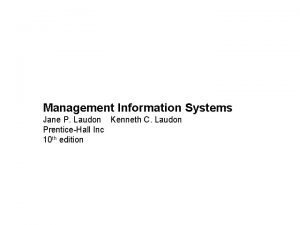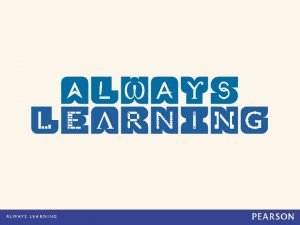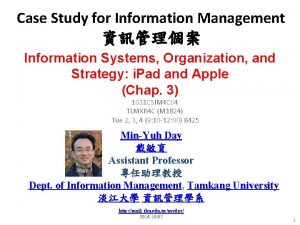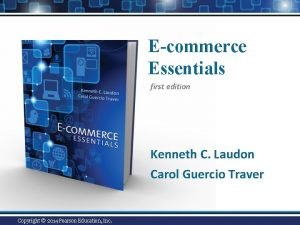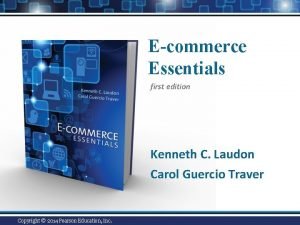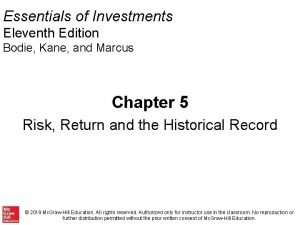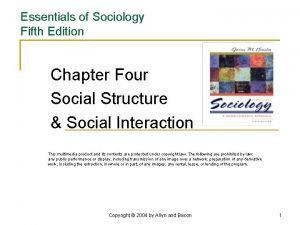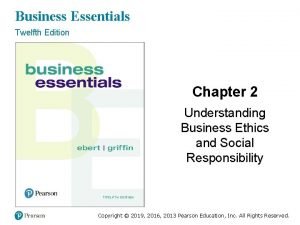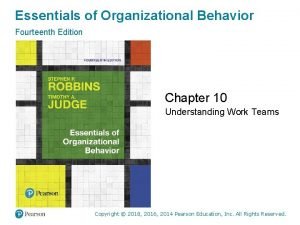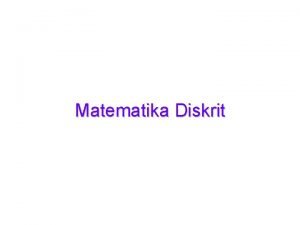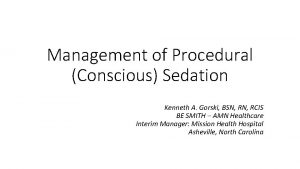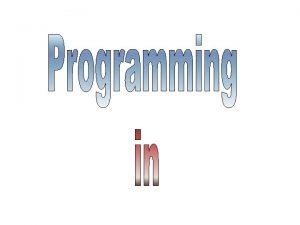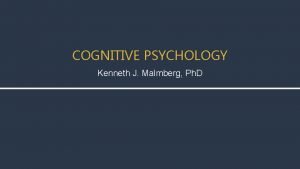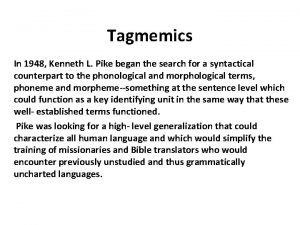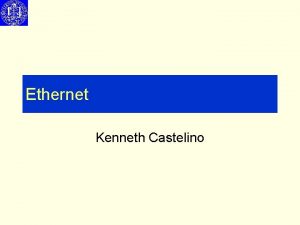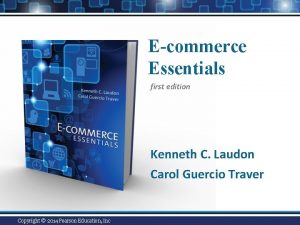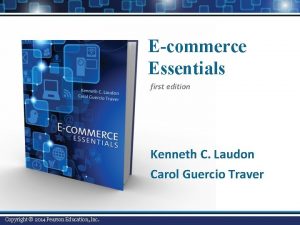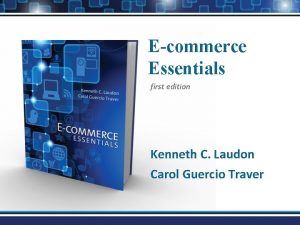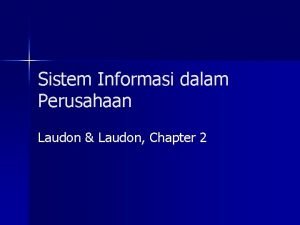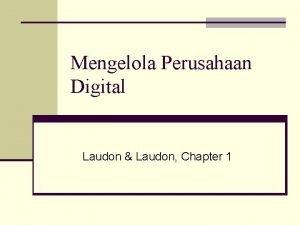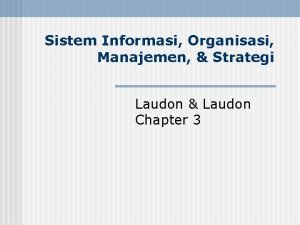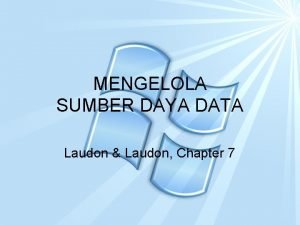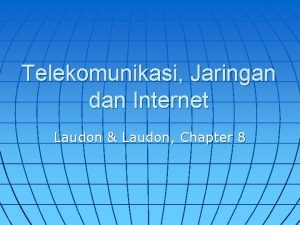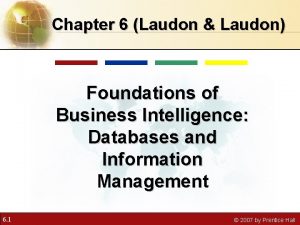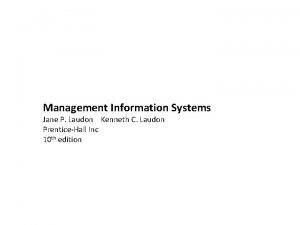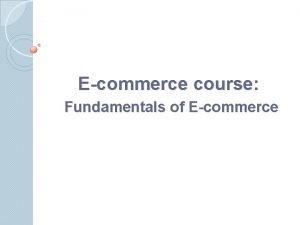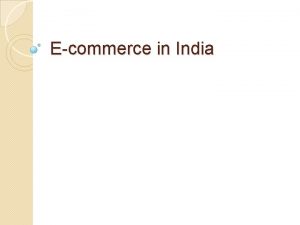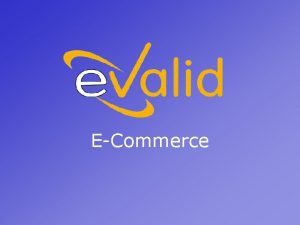Ecommerce Essentials first edition Kenneth C Laudon Carol






































- Slides: 38

E-commerce Essentials first edition Kenneth C. Laudon Carol Guercio Traver Copyright © 2014 Pearson Education, Inc.

Chapter 5 E-commerce Security and Payment Systems Copyright © 2014 Pearson Education, Inc.

Class Discussion Cyberwar: MAD 2. 0 n What is the difference between hacking and cyberwar? n Why has cyberwar become more potentially devastating in the past decade? n Why has Google been the target of so many cyberattacks? n Is it possible to find a political solution to MAD 2. 0? Copyright © 2014 Pearson Education, Inc. Slide 5 -3

The E-commerce Security Environment n Overall size and losses of cybercrime unclear v Reporting issues n 2011 CSI survey: 46% of respondent firms detected breach in last year n Underground economy marketplace v Stolen information stored on underground economy servers Copyright © 2014 Pearson Education, Inc. Slide 5 -4

What is Good E-commerce Security? n To achieve highest degree of security v New technologies v Organizational policies and procedures v Industry standards and government laws Copyright © 2014 Pearson Education, Inc. Slide 5 -5

The E-commerce Security Environment Figure 5. 1, Page 168 Copyright © 2014 Pearson Education, Inc. Slide 5 -6

n Table 5. 1, Page 169 Copyright © 2014 Pearson Education, Inc. Slide 5 -7

Security Threats in the E-commerce Environment n Three key points of vulnerability in e- commerce environment: 1. Client 2. Server 3. Communications pipeline (Internet communications channels) Copyright © 2014 Pearson Education, Inc. Slide 5 -8

Vulnerable Points in an E-commerce Transaction Figure 5. 2, Page 170 Copyright © 2014 Pearson Education, Inc. Slide 5 -9

Most Common Security Threats in the E-commerce Environment n Malicious code v Viruses v Worms v Trojan horses v Drive-by downloads v Backdoors v Bots, botnets v Threats at both client and server levels Copyright © 2014 Pearson Education, Inc. Slide 5 -10

Most Common Security Threats (cont. ) n Potentially unwanted programs (PUPs) v Browser parasites v Adware v Spyware n Phishing v E-mail scams v Social engineering v Identity theft Copyright © 2014 Pearson Education, Inc. Slide 5 -11

Most Common Security Threats (cont. ) n Hacking v Hackers vs. crackers v Types of hackers: White, black, grey hats v Hacktivism n Cybervandalism v Disrupting, defacing, destroying Web site n Data breach v Losing control over corporate information to outsiders Copyright © 2014 Pearson Education, Inc. Slide 5 -12

Most Common Security Threats (cont. ) n Credit card fraud/theft v Hackers target merchant servers; use data to establish credit under false identity n Spoofing (Pharming) n Spam (junk) Web sites n Denial of service (Do. S) attack v Hackers flood site with useless traffic to overwhelm network n Distributed denial of service (DDo. S) attack Copyright © 2014 Pearson Education, Inc. Slide 5 -13

Most Common Security Threats (cont. ) n Sniffing v Eavesdropping program that monitors information traveling over a network n Insider attacks n Poorly designed server and client software n Social network security issues n Mobile platform security issues v Same risks as any Internet device n Cloud security issues Copyright © 2014 Pearson Education, Inc. Slide 5 -14

Insight on Technology: Class Discussion Think Your Smartphone Is Secure? n What types of threats do smartphones face? n Are there any particular vulnerabilities to this type of device? n Are apps more or less likely to be subject to threats than traditional PC software programs? Copyright © 2014 Pearson Education, Inc. Slide 5 -15

Technology Solutions n Protecting Internet communications v Encryption n Securing channels of communication v SSL, VPNs n Protecting networks v Firewalls n Protecting servers and clients Copyright © 2014 Pearson Education, Inc. Slide 5 -16

Tools Available to Achieve Site Security Figure 5. 4, Page 181 Copyright © 2014 Pearson Education, Inc. Slide 5 -17

Encryption n Encryption v Transforms data into cipher text readable only by sender and receiver v Secures stored information and information transmission v Provides 4 of 6 key dimensions of e-commerce security n Message integrity n Nonrepudiation n Authentication n Confidentiality Copyright © 2014 Pearson Education, Inc. Slide 5 -18

Symmetric Key Encryption Sender and receiver use same digital key to encrypt and decrypt message n Requires different set of keys for each transaction n Strength of encryption n v n Length of binary key used to encrypt data Advanced Encryption Standard (AES) Most widely used symmetric key encryption v Uses 128 -, 192 -, and 256 -bit encryption keys v n Other standards use keys with up to 2, 048 bits Copyright © 2014 Pearson Education, Inc. Slide 5 -19

Public Key Encryption n Uses two mathematically related digital keys v Public key (widely disseminated) v Private key (kept secret by owner) n Both keys used to encrypt and decrypt message n Once key used to encrypt message, same key cannot be used to decrypt message n Sender uses recipient’s public key to encrypt message; recipient uses private key to decrypt it Copyright © 2014 Pearson Education, Inc. Slide 5 -20

Public Key Cryptography: A Simple Case Figure 5. 5, Page 184 Copyright © 2014 Pearson Education, Inc. Slide 5 -21

Public Key Encryption Using Digital Signatures and Hash Digests n Hash function: v Mathematical algorithm that produces fixed-length number called message or hash digest Hash digest of message sent to recipient along with message to verify integrity n Hash digest and message encrypted with recipient’s public key n Entire cipher text then encrypted with recipient’s private key—creating digital signature—for authenticity, nonrepudiation n Copyright © 2014 Pearson Education, Inc. Slide 5 -22

Public Key Cryptography with Digital Signatures Figure 5. 6, Page 185 Copyright © 2014 Pearson Education, Inc. Slide 5 -23

Digital Certificates and Public Key Infrastructure (PKI) n Digital certificate includes: v Name of subject/company v Subject’s public key v Digital certificate serial number v Expiration date, issuance date v Digital signature of CA n Public Key Infrastructure (PKI): v CAs and digital certificate procedures v PGP Copyright © 2014 Pearson Education, Inc. Slide 5 -24

Digital Certificates and Certification Authorities Figure 5. 7, Page 187 Copyright © 2014 Pearson Education, Inc. Slide 5 -25

Limits to Encryption Solutions n Doesn’t protect storage of private key v PKI not effective against insiders, employees v Protection of private keys by individuals may be haphazard n No guarantee that verifying computer of merchant is secure Copyright © 2014 Pearson Education, Inc. Slide 5 -26

Insight on Society: Class Discussion Web Dogs and Anonymity: Identity 2. 0 n What are some of the benefits of continuing the anonymity of the Internet? n Who are the groups involved in creating an identity system for the Internet? n Who should control a central identity system? Copyright © 2014 Pearson Education, Inc. Slide 5 -27

Securing Channels of Communication n Secure Sockets Layer (SSL) and Transport Layer Security (TLS) v Establishes a secure, negotiated client-server session in which URL of requested document, along with contents, is encrypted n Virtual Private Network (VPN) v Allows remote users to securely access internal network via the Internet Copyright © 2014 Pearson Education, Inc. Slide 5 -28

Secure Negotiated Sessions Using SSL/TLS Figure 5. 8, Page 189 Copyright © 2014 Pearson Education, Inc. Slide 5 -29

Protecting Networks n Firewall v Hardware or software v Uses security policy to filter packets n Proxy servers (proxies) v Software servers that handle all communications originating from or being sent to the Internet Copyright © 2014 Pearson Education, Inc. Slide 5 -30

Protecting Servers and Clients n Operating system security enhancements v Upgrades, patches n Anti-virus software v Easiest and least expensive way to prevent threats to system integrity v Requires daily updates Copyright © 2014 Pearson Education, Inc. Slide 5 -31

E-commerce Payment Systems n Credit cards v Still the dominant online payment method in United States n Limitations of online credit card payment systems v Security, merchant risk v Cost v Social equity Copyright © 2014 Pearson Education, Inc. Slide 5 -32

How an Online Credit Transaction Works Figure 5. 10, Page 193 Copyright © 2014 Pearson Education, Inc. Slide 5 -33

Alternative Online Payment Systems n Online stored value systems v Based on value stored in a consumer’s bank, checking, or credit card account v e. g. : Pay. Pal n Other alternatives v Amazon Payments v Google Checkout Copyright © 2014 Pearson Education, Inc. Slide 5 -34

Mobile Payment Systems n Use of mobile phones as payment devices established in Europe, Japan, South Korea n Near field communication (NFC) v Short-range (2”) wireless for sharing data between devices n Expanding in United States v Google Wallet n Mobile app designed to work with NFC chips v Pay. Pal v Square Copyright © 2014 Pearson Education, Inc. Slide 5 -35

Digital Cash and Virtual Currencies n Digital cash v Based on algorithm that generates unique tokens that can be used in “real” world v e. g. : Bitcoin n Virtual currencies v Circulate within internal virtual world v e. g. : Linden Dollars in Second Life, Facebook Credits Copyright © 2014 Pearson Education, Inc. Slide 5 -36

Electronic Billing Presentment and Payment (EBPP) n Online payment systems for monthly bills n 50% of all bill payments n Two competing EBPP business models: v Biller-direct (dominant model) v Consolidator n Both models are supported by EBPP infrastructure providers Copyright © 2014 Pearson Education, Inc. Slide 5 -37

Copyright © 2014 Pearson Education, Inc. Slide 5 -38
 Kenneth c. laudon jane p. laudon
Kenneth c. laudon jane p. laudon Laudon laudon schoder
Laudon laudon schoder Management information system case study
Management information system case study Laudon and laudon 2012
Laudon and laudon 2012 E-commerce presence map
E-commerce presence map Kenneth c. laudon
Kenneth c. laudon Kenneth ott ecommerce
Kenneth ott ecommerce Network security essentials 5th edition
Network security essentials 5th edition Business essentials 12th edition chapter 1
Business essentials 12th edition chapter 1 Essentials of investments 11th edition
Essentials of investments 11th edition Business essentials 12th edition answer key
Business essentials 12th edition answer key Essentials of sociology 5th edition
Essentials of sociology 5th edition Firefighter essentials 7th edition
Firefighter essentials 7th edition Business essentials 12th edition
Business essentials 12th edition Management information systems 13th edition
Management information systems 13th edition Essentials of organizational behavior 14th edition
Essentials of organizational behavior 14th edition At a bulk transport incident firefighters must
At a bulk transport incident firefighters must Cryptographic systems are generically classified by
Cryptographic systems are generically classified by Criminal justice the essentials 5th edition
Criminal justice the essentials 5th edition Using mis (10th edition) 10th edition
Using mis (10th edition) 10th edition Chapter 1
Chapter 1 Kinder- und hausmärchen first edition
Kinder- und hausmärchen first edition Emergency medical responder first on scene
Emergency medical responder first on scene Emergency medical responder first on scene 10th edition
Emergency medical responder first on scene 10th edition Emergency medical responder first on scene 11th edition
Emergency medical responder first on scene 11th edition Kunci jawaban buku rosen
Kunci jawaban buku rosen Dr kenneth gorski
Dr kenneth gorski Kenneth nelson sofi
Kenneth nelson sofi Kenneth lane thompson
Kenneth lane thompson Einar bergsholm
Einar bergsholm First filipino expert on fingerprinting
First filipino expert on fingerprinting Dramatism of kenneth burke
Dramatism of kenneth burke Kenneth malmberg
Kenneth malmberg Dr kenneth wang
Dr kenneth wang Kenneth røn christiansen
Kenneth røn christiansen K l pike
K l pike Csmscd
Csmscd Kenneth ceciliano moreira
Kenneth ceciliano moreira Kenneth ellerbee
Kenneth ellerbee
